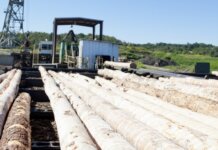
ABOVE An irrigation system slakes the thirst of Jim Lewey’s Carr Farms in Geneva County. Photos by Todd Douglas
Jim Lewey is not your father’s farmer. He’s young, articulate and college educated. And he runs Carr Farms — thousands of fertile acres near the Florida border — like the sizeable, multifaceted business that it is.
On cropland in south Alabama’s Geneva County, Lewey grows corn, cotton, soybeans and peanuts, along with grazing crops for his cattle. Carr and other modern farms operate much differently than those a few decades ago, thanks to advances in technology.
Yet better irrigation methods are needed to meet Alabama’s agricultural needs. Improved irrigation methods exist, but farmers must be taught how to apply these new technologies.
“We (Alabama farmers) need the knowledge to utilize this technology, but there has not been any support behind it, ” says Lewey. “The technology is available, but the data is not yet out there to tell us how to use it.”

|
Help is on the way.
Auburn University will teach Lewey and other farmers how to use irrigation practices, such as sensor-based irrigation scheduling and variable rate irrigation. The project is funded primarily with nearly $1 million from the Conservation Innovation Grants program of the Natural Resources and Conservation Service, a division of the U.S. Department of Agriculture.
The three-year project begins this spring at four farms that serve as demonstration sites — three in north Alabama and Carr Farms in south Alabama. The soils on these farms represent key agricultural areas in Alabama, and the findings from these sites will guide farmers on how to irrigate corn, soybeans and cotton in north and southeast Alabama.
Grant money also will be used to demonstrate the benefits of having an irrigation pond to store water during the winter for irrigation in the summer. Leading the project is Brenda Ortiz, associate professor in the Auburn College of Agriculture’s Department of Crop, Soil and Environmental Sciences and an agronomist with the Alabama Cooperative Extension System.
“The key to better irrigation management is to increase water use efficiency to achieve the highest yield possible with the least amount of water, ” Ortiz explains. “In order to increase water use efficiency, we need to be able to determine and apply the right rate of water at the right location and the right time. The technology of variable rate irrigation allows application of different rates of water over a field.”
Soil sensors installed at different areas in the field monitor soil moisture and help farmers determine the amount of water needed in a specific area and time. Put simply, it pinpoints and customizes water use.
Roughly 10 percent of Alabama’s 1.1 million acres of cropland are irrigated compared to 50 percent in Georgia and 60 percent in Mississippi. If 50 percent of Alabama’s current row crop acreage were irrigated, the statewide economic impact would be $200 million to $300 million a year, says Richard McNider, a professor in the University of Alabama in Huntsville’s Department of Atmospheric Science, who led an earlier initiative that focused on how to get more Alabama cropland under irrigation.

Ortiz identifies several reasons why Alabama has less irrigated cropland than neighboring states. Alabama farmers need to dig deeper wells than their neighbors in Georgia, where aquifers are closer to the surface. Also, much of Alabama’s cropland is rented, and farmers tend not to invest in irrigation systems on rented land.
“Alabama really doesn’t have that much groundwater, ” adds McNider. “For example, a farmer in Alabama might have to dig a 600-foot-deep well compared to 30 feet in Georgia.”
This makes digging wells in Alabama expensive, as Lewey has discovered: “We have a few wells, but it can cost $40, 000 to $50, 000 to drop a well. Our focus is mainly on trying to trap and catch as much water off-season through ponds and reservoirs.”
Adequate water also means applying it at the right rate, at the right time and in the right place, Ortiz says.
“Even if farmers have irrigation systems, they still struggle to determine the right amount of water. Technology can help with that.”
Variable rate irrigation technology allows application of different rates of water within a field, and then the farmer can change the water rates according to the characteristics of the location, such as soil type and terrain elevation. Data from sensors allows farmers to apply water at the right rate and at the right time.

“The farming community in Alabama was used to relying on rainfall for growing their crops, ” Ortiz points out. “However, the recent changes in weather and climate patterns, including the frequent and prolonged droughts, are imposing a huge risk to crop production. Farmers realize they can no longer rely on rainfall, and if they do, there is no guarantee the rainfall will be well distributed and occur at the right time and in the right amount. Irrigated agriculture will always result in higher yields.”
Various pressures on California’s water supply are another reason to improve irrigation methods and increase the amount of irrigated cropland in Alabama, says John Christy, professor of atmospheric science and director of the Earth System Science Center at the University of Alabama in Huntsville. He believes it makes sense to grow high water-use crops, such as corn and soybeans, in a region with significant growing-season rain such as the Southeast.
“I’m a native of Fresno County, California — the heart of California’s agricultural productivity — and the climate of the San Joaquin Valley is essentially that of a desert, so the crops require irrigation for all of their water needs, often 2 to 4 feet of water per crop, ” Christy adds.
“Some alfalfa fields in southern California use over 15 feet per year. However, because we receive rain during Alabama’s growing season, our crops only need small amounts of irrigated water during dry spells. For a season as a whole, this might be only 6 to 10 extra inches of water. So, you can see that in Alabama irrigation is a supplement to the rain provided by Mother Nature; whereas, in California, without irrigation all you have is dust and tumbleweeds. And finding water in a desert is expensive, paid in considerable part by federal tax dollars.”
This is an environmentally sustainable path, he says, because Alabama needs only “a tiny fraction” of its total water supply for irrigation; whereas, California requires a major portion, which degrades the state’s natural ecology.

Puneet Srivastava, professor of biosystems engineering at Auburn University and director of the Water Resources Center, says Alabama is based on riparian water rights, a system for allocating water among those who possess land along its path, so farmers whose property does not touch a body of water do not have access to water.
Even farmers whose property abuts small streams do not have adequate water supply for irrigation, because much of Alabama’s rain is in the non-growing winter months, Srivastava says. Yet water is needed in the summer growing season.
Since groundwater isn’t a viable source for irrigation in much of the state, farmers must rely on surface water.
An alternative is to withdraw water from creeks or streams and store it in irrigation ponds or reservoirs for summer irrigation. This option is viable if reservoirs are of an adequate size.
“Farmers need to build big enough reservoirs to hold water harvested in winter months to supply water to their crops for the entire growing season, ” Srivastava continues. “Unfortunately, farmers usually do not like to allocate large tracts of land for reservoirs. The result is a situation where they need to withdraw water from streams in summer months when the stream-flows are low. ”
Srivastava says adequately sized reservoirs would help with summer irrigation and increase crop productivity, while protecting environmental stream flows. That would provide a workable irrigation solution for most Alabama farmers, he says, if state legislation is created to allow non-riparian farmers access to water.
On Carr Farms, irrigation takes time, money and labor and is “something you must commit to, ” Lewey says. “The cool thing about this new technology is that it affects the most important things in life — oxygen, water and food.”
New Irrigation Legislation
Irrigation improvements by farmers were facilitated by several measures passed during the 2018 Regular Session of the Alabama Legislature. One bill clarifies existing laws, saying farmers may claim a $10, 000 credit for one qualifying irrigation system or reservoir in 2011-17 and $50, 000 for another system during 2018-22. Also, the General Fund includes $81, 403 in matching funds for on-farm irrigation through the federal Regional Conservation Partnership Program.
Jessica Armstrong and Todd Douglas are freelance contributors to Business Alabama. Both are based in Florida.



